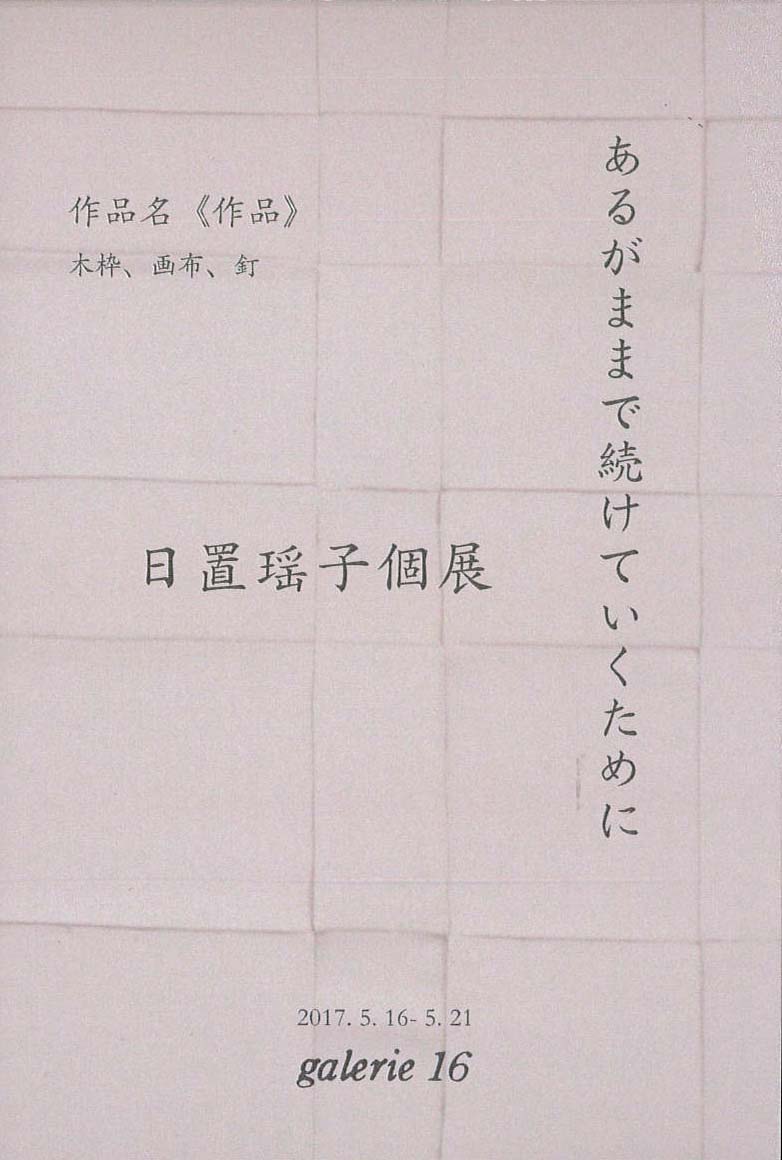あるがままで続けていくために

2017年5月16日(火)〜5月21日(日)
12:00〜19:00(最終日〜18:00)
日 置 瑶 子 Yoko HIOKI
2016年 京都大学大学院修士課程修了
現在 京都大学大学院博士課程在学
【主なグループ展】
2013年 「The Forms of Light」キュービックギャラリー(大阪)
【主な研究発表】
2015年 「クリストとジャンヌ゠クロードの作品 1960 年代以降の作品を中心に」
第66回美学会全国大会若手研究者フォーラム(早稲田大学戸山キャンパス36号館、東京)
2016年 「クリストとジャンヌ=クロードの芸術活動におけるクリストのコラージュをめぐって」
第67回美学会全国大会本発表(同志社大学室町キャンパス寒梅館、京都)
【上記以外の活動】
2015年 「展評 うつろい : アートディレクター篠原資明キュレーションによる」
『あいだ/生成』, あいだ哲学会, 5, 67-72.
2016年〜 キュレトリアル・インターン(大阪)
▶コメント・作家ステートメント
日置は、つくるチャンネルにおいて次のように感じている。作品は、そのもの(美)・自分の可能性を広げた感覚(喜び)・自分や目の前の人やものを続けさせること(愛)、これら3つが、場において、トライアングルのように互いに補い合い働いて成立する、と。他の意見もあるだろう。が、彼女の考えはそんなに外れているものでもないだろう。
この展覧会でも、「そのもので そのものを こえること」が試みられ、日置の関心ごとである「作品とは何か」が彼女なりに表現されつつ、先人たちの仕事をこえようとする姿勢がみられる。
————————————————-
「あるがままで続けていくために」 日置 瑶子
私には作家としての信念がひとつある。それは、美術に関わる人や場、ものが続くために制作することにある。
さて、私たちは、ギャラリー16の展覧会の空間に一歩入る。私たちは、キャンバスが、天井から吊られ、壁から浮いているのをみる。一度裁断された画布が、交互に編まれるように重なり合いながら張られて、釘で木枠にとめられている。新たにできた編み目、凹凸、影はキャンバスがみずから生んだものだ。
私は、本作《作品》で3つの事柄を試みる。ひとつめは、1枚の絵画の視覚的な範囲に、芸術家の内面あるいは芸術家の意図したイメージを入れないようにしながら、絵画をつくることだ。本作は、こうしたシリーズの最初のシリーズだ。日本で私はジャクソン・ポロックやゲルハルト・リヒターの仕事を越えた先にあるものをみせる。私には、彼らもまた抽象絵画に関する課題を解決しようと試みていたと思われる。
第2は、キャンバスで芸術作品をつくることだ。本作の素材は、キャンバスといった描くための支持体とキャンバスがもつ美術の制度だ。言い換えれば、以前の私たちの感じ方ともいえる。この狙いは、私たちが以前のすべての感じ方を捨てるのではなしに、むしろ以前の感じ方を使ってそれを引き継ぎながら、自分の許す範囲内で自分の感じ方を新しくすることにある。私には、私たちは感じたことのない他の感覚を得る際には、私たちは自分で自分の可能性の幅を広げていると思われる。それは私たちが自分で自分を創造している感覚を得るということを意味する。本作で、キャンバスも、美術制度もまた自分自身で可能性を拡げる。
第3は、「作品とは何か」について私なりの答えを表現すること。これは、第2の事柄に関係している。私は次のように考える。誰かや何かを続けようとすることが愛。知覚の変化が美。自分の可能性を拡げた感覚に喜びがある。作品とは、ある場で美と喜びと愛が揃うと生まれる。芸術作品が生まれる場所では、「作り手・作品・受け手」といった3つの対立は解消されると思われる。こうした考えが本作に込められている。
————————————————-
“Survive as it is by changing the part″ Yoko Hioki
I have the belief as an artist. My belief is to create for keeping people, places and things involved in art.
Now, we step into the exhibition space of the Gallery 16, Kyoto. We can see several canvases that are hung from the ceiling and lifted up from the wall. We find that canvases were cut with a scissors once, are knitted alternately, are stretched, and are fasten up the wooden frame with nails. The newly formed stitches, irregularities, and shadows were created by the canvas itself.
I try three things in this work the work of art. Firstly, I demonstrate a painting without the artist’s internal mind or the artist’s image intended, in the visual range of a painting. This work is the first series of such kinds of series. In Japan I show you something beyond the work of Jackson Pollock and Gerhard Richter. I think that Pollock and Richter also tried to solve the problem related to abstract paintings.
Secondly, I create a work of art using the canvas. The material of this work is the canvas which is the support for paintings, and the art system the canvas has. In other words, it can be said as the consciousness that we have before. This aim is not to abandon all our previous perception, but rather to renew our ways of thinking within the scope of ourselves, taking over it using the way we feel so far. When we get another sense we have not felt, I think that we broaden our range of possibilities by ourselves. It means that we get the sense that we create ourselves by ourselves. In this work, the canvas and the art system also expand possibilities by themselves.
Thirdly, I express my answer about “What is works of art?”. This relates to the second thing. I think as follows. Love is to let someone or something keeping its way. Beauty is the change in perception. There is joy in the sense that we expand our own possibilities. The work of art is born when beauty, joy and love are gathered in one place. I think that three conflicts such as “artist, work, and viewer” will be resolved in the place where the work of art is generated. These ideas are included in this work.
————————————————-

